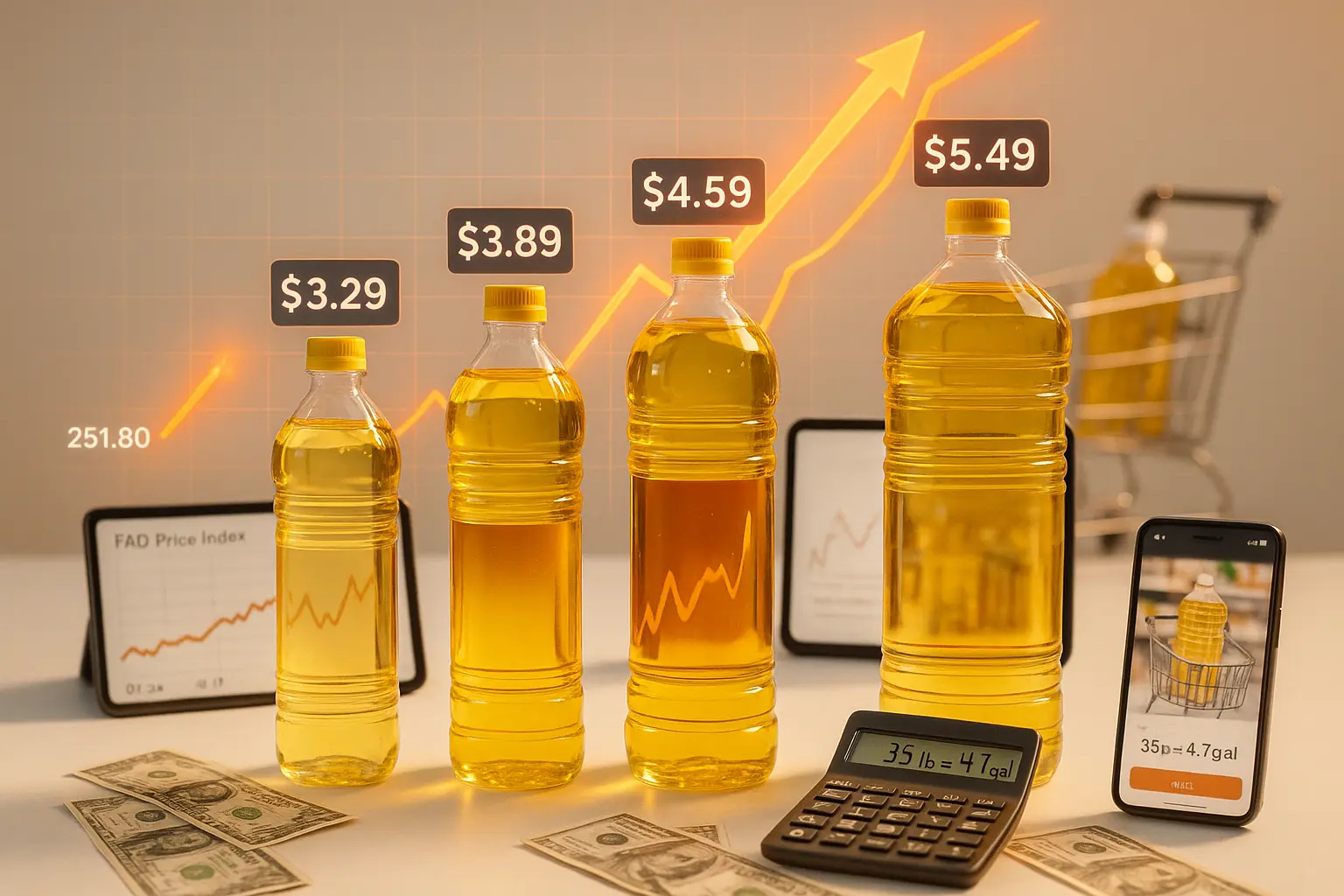Prices verified June 2025
Jump to a question:
Why is vegetable oil still expensive in 2025?
Vegetable oil remains expensive in 2025 due to lingering supply chain impacts from the 2022 surge when the FAO Oils Price Index hit 251.80 Points, combined with sustained biodiesel demand consuming 30% of global production.
The world Oils Price Index averaged 92.54 Points from 1990-2025 according to FAO data, making current prices nearly double historical norms. Global disruptions including weather events in major palm oil corridors and increased renewable fuel mandates maintain pressure on the crude vegetable oil benchmark.
Restaurant operators face particular challenges as oil represents 8-12% of food costs for operations specializing in fried items. The sunflower oil corridor disruption from the Ukraine conflict removed 80% of global exports, forcing costly substitutions that persist today.
Key takeaways: • Compare bulk tote pricing across 3+ suppliers for 20-30% savings • Lock in 6-month contracts during seasonal price dips (typically October-December) • Monitor the FAO monthly price index for timing purchases
Historical data shows the record low of 35.80 Index Points in February 2001 per FAO records, demonstrating today’s seven-fold increase. While 2025 prices retreated from peaks, structural changes including higher oleic acid content requirements for industrial use keep values elevated.
Summary: Vegetable oil stays expensive due to the FAO index remaining at 180+ Points versus the 92.54 historical average. Supply constraints and 30% biodiesel demand share maintain prices at double pre-2020 levels through structural market shifts.

Grease Connections
How many gallons is 35 lb vegetable oil?
35 pounds of vegetable oil equals 4.7 gallons (17.8 liters), calculated using the industry-standard density of 7.5 pounds per gallon at 70°F per the National Institute of Standards and Technology.
This conversion proves essential for restaurants comparing bulk supplier quotes between weight and volume units. Temperature affects density—cooler oil becomes denser while heated oil expands approximately 4% at frying temperatures.
Key takeaways: • Use 7.5 lb/gal for room temperature conversions • Store oil below 75°F to maintain accurate measurements • Request volume pricing to simplify comparisons
Quick conversion table:
| Pounds | Gallons | Liters |
|---|---|---|
| 35 lb | 4.7 gal | 17.8 L |
| 50 lb | 6.7 gal | 25.4 L |
| 100 lb | 13.3 gal | 50.3 L |
Bulk purchasing in 35-pound containers typically offers 15-20% savings over retail gallons. Commercial kitchens benefit from these volume discounts when storage space permits.
Summary: Convert 35 pounds to 4.7 gallons using the NIST standard 7.5 lb/gal density. Temperature variations affect measurements by up to 4%, making proper storage essential for accurate inventory tracking.

Grease Connections
How much is 1 liter of cooking oil?
One liter of cooking oil costs US$2.50-$4.00 (€2.30-€3.70) at retail in 2025, with individual retailers setting prices that vary 40% between discount and premium stores according to USDA retail monitoring data.
Grocery Outlet and warehouse clubs offer the lowest per-liter pricing at US$2.00-$2.50 when buying 4-liter containers. Same-day delivery through Instacart adds 15-20% markup but provides convenience for immediate needs.
Key takeaways: • Download store apps to track weekly oil promotions • Buy during quarterly stock-up sales for 25% savings • Consider warehouse membership if using 10+ liters monthly
Pricing varies among retailers based on:
- Location and local competition
- Store positioning (discount vs. premium)
- Oil grade and filtration level
- Container size and packaging
Smart shoppers leverage price-matching policies and digital coupons to maximize savings. Apps comparing prices across retailers identify optimal purchase timing.
Summary: Expect US$2.50-$4.00 per liter depending on retailer type and location. Warehouse clubs offer best pricing at US$2.00/liter in bulk, while convenience stores charge premium rates up to US$4.00/liter.

Grease Connections
What is the cheapest type of vegetable oil?
Soybean oil ranks cheapest at US$7-$9/gallon ($1.85-$2.38/L), followed by corn oil blends, while specialty oils like avocado cost US$25-$35/gallon ($6.60-$9.25/L) according to USDA Agricultural Marketing Service data.
Price-conscious buyers find soybean oil delivers excellent value with its 450°F smoke point suitable for all cooking methods. Its neutral flavor profile and stable shelf life make it the foodservice industry standard.
Key takeaways: • Choose soybean oil for 60% savings over premium options • Buy store brands for additional 20-30% discount • Avoid specialty oils unless specific recipes require them
Cost comparison per gallon (June 2025 USDA prices):
- Soybean oil: US$7-$9 ($1.85-$2.38/L)
- Corn oil: US$8-$10 ($2.11-$2.64/L)
- Vegetable blend: US$8-$11 ($2.11-$2.91/L)
- Canola oil: US$10-$14 ($2.64-$3.70/L)
- Peanut oil: US$15-$20 ($3.96-$5.28/L)
Store brands consistently undercut national brands by 25% while meeting identical quality specifications. Great Value and Kirkland Signature provide reliable alternatives for budget-conscious operations.
Summary: Soybean oil offers lowest cost at US$7-$9/gallon, making it ideal for high-volume users. Store brand blends provide similar savings with comparable performance for all standard cooking applications.

Grease Connections
What is the market price for used cooking oil?
Used cooking oil commands US$2.50-$3.50/gallon ($0.66-$0.92/L) in 2025 markets according to Jacobsen biodiesel pricing data, with clean yellow grease fetching premium rates while contaminated oil incurs disposal fees.
Current pricing reflects biodiesel mandate requirements consuming 4 billion gallons annually per EPA data. Restaurants maintaining oil quality through proper filtration offset 30-40% of fresh oil costs through recycling programs.
Key takeaways: • Filter oil daily to maintain premium grade status • Contract with established collectors for best rates • Track gallons collected to verify payment accuracy
Market dynamics favor high-volume producers:
- Biodiesel correlation to petroleum prices (0.85 coefficient)
- Seasonal peaks during summer driving season
- Regional variations based on refinery proximity
- Quality premiums for low-moisture content
Smart operators prevent water contamination and maintain covered storage to maximize oil value. Professional collection ensures compliance while generating revenue.
Summary: Used oil markets pay US$2.50-$3.50/gallon for quality restaurant oil per Jacobsen data. Clean, high-volume producers secure best pricing through contracted relationships versus volatile spot markets.

Grease Connections
Will vegetable oil prices drop in 2026?
Vegetable oil prices may moderate 10-15% by 2026 according to USDA projections, though structural factors including biodiesel mandates and climate volatility prevent return to pre-2020 levels near the 35.80 Index Point historical low.
FAO economists project the vegetable oil price index stabilizing around 150-170 Points through 2026, compared to the current 180+ level. This represents improvement from the 251.80 peak but remains 65% above the long-term average.
Key takeaways: • Lock in forward contracts if offered below current spot prices • Diversify oil types to hedge against specific commodity spikes • Invest in oil-saving equipment for long-term cost reduction
Factors supporting gradual price relief:
- Expanded crushing capacity coming online
- Improved yields from drought-resistant varieties
- Potential easing of biodiesel blend requirements
- Normalized shipping costs post-pandemic
However, increasing industrial demand for high-oleic varieties and persistent weather risks limit downside potential. Most analysts expect a “higher for longer” scenario.
Summary: Expect modest 10-15% price relief by 2026 per USDA forecasts, stabilizing around 150-170 Index Points. Structural demand changes prevent return to historical lows, requiring businesses to adapt to permanently higher oil costs.

Grease Connections
What’s in Great Value vegetable oil?
Great Value vegetable oil contains 100% soybean oil refined to remove proteins and achieve a 450°F smoke point, matching national brand specifications at 25% lower cost according to Walmart’s published ingredient data.
Walmart’s store brand undergoes identical refining processes as premium oils, removing free fatty acids and achieving neutral flavor. The standardized processing ensures consistent performance across production batches.
Key takeaways: • Verify “100% soybean oil” on labels to ensure single-source quality • Check production dates for freshness (use within 24 months) • Store below 75°F to prevent rancidity
Label analysis reveals:
- No trans fats per FDA regulations
- Natural vitamin E content (1.4mg per tablespoon)
- Refined, bleached, deodorized (RBD) processing
- No artificial additives or preservatives
- Allergen-free per FDA guidelines
Budget-conscious operators rely on Great Value for consistent quality matching premium brands. Independent testing confirms comparable oxidative stability and frying performance.
Summary: Great Value contains 100% refined soybean oil matching premium brand quality per Walmart specifications. The pure, additive-free formula delivers identical cooking performance at 25% savings versus national brands.

Grease Connections
Complete Summary
Vegetable oil prices remain elevated at 180+ FAO Index Points in 2025—double the 92.54 historical average—due to biodiesel consuming 30% of production and ongoing supply disruptions. Soybean oil offers best value at US$7-$9/gallon while specialty oils cost 3-5x more. Smart buyers save 40% through bulk purchasing, store brands like Great Value (100% soybean oil), and recycling programs paying US$2.50-$3.50/gallon for used oil. Convert 35 pounds to 4.7 gallons using the 7.5 lb/gal standard. Expect modest 10-15% price relief by 2026, though structural changes prevent return to pre-2020 levels.
Want personalized strategies to lower your oil spend? Request a free bulk-pricing audit today.









